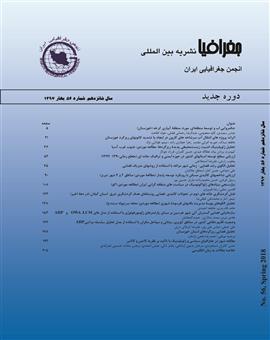تحلیل نقش گردشگری خانه های دوم در تحولات کالبدی-فضایی روستاهای هدف گردشگری شرق استان گیلان در دهه اخیر
محورهای موضوعی :محمدتقی لطفی نیا 1 , تیمور آمار 2
1 - دانشگاه آزاد اسلامی واحد رشت
2 - دانشگاه آزاد اسلامی واحد رشت
کلید واژه: گردشگری خانه های دوم تحولات کالبدی-فضایی روستاهای هدف گردشگری شرق گیلان,
چکیده مقاله :
گردشگری خانه های دوم یکی از الگوهای گسترش گردشگری در نواحی روستایی است که برای مقاصد تفریحی و فراغتی خریداری و یا ساخته شده و سبب تاثیرات مختلف از جمله تاثیرات کالبدی-فضایی در روستاها می شود . هدف این پژوهش بررسی نقش گردشگری خانه های دوم در تحولات کالبدی-فضایی روستاهای هدف گردشگری شرق استان گیلان در دهه اخیر(1395-1385) است. روش تحقيق در اين مطالعه توصيفي- تحليلي است كه بخش عمدهاي از داده هاي آن بر اساس مطالعات ميدانی صورت گرفته است. نتایج نشان میدهد که دهه اخیرگردشگری خانه های دوم در زمینه کالبدی فضایی اگرچه سبب اثرات و پیامدهای مثبت همچون نوسازی ساختمان ها و بهبود کالبد روستا،استفاده از مصالح پردوام در ساخت و سازها،کاهش اراضی متروک و بی استفاده جهت احداث خانه های دوم،بهبود تاسیسات و تجهیزات روستا در این روستاها شده اما اثرات و پیامدهای منفی از قبیل تغییر و تخریب اراضی کشاورزی،تغییر کاربری اراضی،برهم زدن و تخریب چشم انداز روستا و تغییر الگوی مسکن و... را به همراه داشته است.براساس یافته های تحقیق در سال 95 تعداد 169 خانه دوم در ناحیه مطالعاتی احداث شده که از رشد 6/110 درصدی نسبت به سال 85برخوردار بوده که این راستا روستاهای انبارسر و بالارود به ترتیب با دارا بودن 55 و 42 خانه دوم بیشترین تعداد خانه های دوم را در بین روستاهای مورد مطالعه داشته و همچنین بیشترین تغییرات کاربری اراضی در دهه اخیر به ترتیب در روستاهای حسن سرا(6/56هکتار) و انبارسر(3/22هکتار) رخ داده است.
Tourism is the second homes of one of the patterns of tourism development in rural areas that has been purchased or built for recreational purposes and has various impacts, including physical-spatial effects in the villages. The purpose of this research is to investigate the role of tourism in second homes in the physical-spatial changes of villages of the tourism destination villages of East of Guilan province in the last decade (2006 - 2016). The methodology of this study is descriptive-analytic. Most of the data has been conducted based on field studies. The results show that the recent development of second homes in the physical space, although leads to positive effects and impacts such as renovation of buildings and improvement of the village structure, the use of long-term materials in construction, the reduction of abandoned and unused land for the construction of second homes, improvement of plants and equipment of the village in these villages, but have had the negative effects and impacts such as alteration and degradation of agricultural lands, land use change, disturbing and destroying the village landscape, and changing the pattern of housing .... Based on the findings of the research, in 2016, the number of 169 second homes has been constructed in the villages of the study area, which had a growth of 110.6% in comparison with the 2006, and in this regard, the villages of Anbarsar and Balarood with 55 and 42 second homes, respectively, have the maximum second homes among villages as well as the maximum land use changes in the last decade has occurred in Hassan Sara (56.6 hectares) and Anbarsar (22.3 hectares), respectively.
